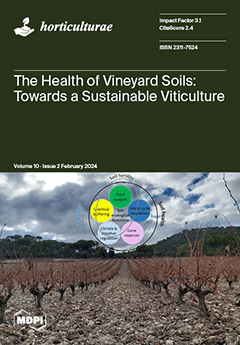Litchi (
Litchi chinensis Sonn.) is considered one of the most important sub-tropical fruits of the world. In the western part of Odisha, India, litchi growers are facing problems of unstable and lower marketable yield and inferior quality due to a higher incidence of fruit cracking, fruit drop, low sugar content, and higher fruit acidity. Keeping in mind the positive effects of nutrients and bioregulators, the current study was conducted to elucidate their impact on fruit yield and quality in the farmers’ field of Jamankira block in Sambalpur district of Odisha, which is under the care of Odisha University of Agriculture and Technology, India. For this study, eight-year-old litchi trees were selected. With 12 treatments, the experiment was set up in a Randomized Block Design replicated thrice, as follows: T
1: spray treatment with Borax—0.5%; T
2: spray treatment with Borax—0.3%; T
3: spray treatment with ZnSO
4—0.75%; T
4: spray treatment with ZnSO
4—0.5%; T
5: spray treatment with CaCl
2—0.5%; T
6: spray treatment with CaCl
2—0.1%; T
7: spray treatment with humic acid—1.5%; T
8: spray treatment with humic acid—1%; T
9: spray treatment with seaweed extract—0.5%; T
10: spray treatment with seaweed extract—0.1%; T
11: foliar spray with NAA—20 ppm; and T
12: control (Water Spray). The current study compared foliar feeding treatments comprising different nutrient and bioregulators, which were applied during the first week of December, just after the completed formation of new leaves and the untreated control. The highest total number of fruits per plant was recorded in plants sprayed with 0.5% ZnSO
4 (T
4) followed by those treated with 1% humic acid (T
8). The highest total fruit yield was recorded in plants subjected to foliar feeding with 0.3% Borax (T
2) which was found to be statistically similar to plants treated with 0.1% seaweed extract (T
10) and 0.5% seaweed extract (T
9). Among the treatments, a better response, i.e., a higher number of marketable fruits and marketable yield, was recorded in litchi plants treated with 0.3% Borax (T
2) followed by 0.5% zinc sulphate (T
4), 1% humic acid (T
8), and 0.1% CaCl
2 (T
6). The application of 1% humic acid (T
8) followed by 1.5% humic acid (T
9) enhanced fruit setting (%) and fruit retention rates (%) and reduced the fruit drop rate (%). The enhanced fruit size (fruit length and fruit width) and higher fruit weight was obtained in litchi plants treated with 0.3% Borax. The foliar application of 0.3% Borax (T
2) also resulted in a higher TSS, total sugars, reducing sugar content, lower acidity, the highest aril weight, and lower seed weight in litchi cv. Bombai. In this research, among the five principal components, only PC1 demonstrated approximately 45.14% variability within the influential axes. PC1 contributed the highest proportion (48.9%) to the overall variability, followed by PC2 with 29.1%, PC3 with 11.9%, PC4 with 0.59%, and PC5 with 0.20%. Consequently, the outcomes of the principal component analysis indicate the presence of extensive variability among treatments.
Full article





